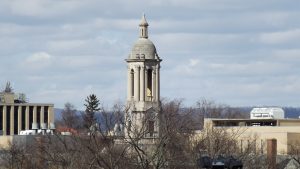It’s easy to make small, incremental changes.
In the world of stormwater, that might mean installing a rain garden or green roof. And while the little changes can help, it’s the big plans that make the most significant differences.
That’s what Hong Wu, assistant professor of landscape architecture at Pennsylvania State University (PSU; State College) had in mind when she proposed a comprehensive water quality improvement plan for the university. Her vision is to make PSU a national leader in green stormwater infrastructure.
Green infrastructure improves water quality and quantity
It wasn’t easy to start bringing Wu’s vision into reality.

A seed grant program offered by Pennsylvania State University (PSU; State College) will help Hong Wu, assistant professor of landscape architecture, create a far-reaching plan to incorporate green infrastructure into future stormwater management projects. Wu is also working across departments to emphasize green infrastructure in engineering and hydrology courses. Alefar/Pixabay
“Pitching this was difficult,” Wu said. “My own efforts started in 2017. We have a Center for Ecology and Design which was supporting performance assessment, trying to use data to inform the next generation of design.”
The college had some green infrastructure, but much of it was outdated. Wu first proposed efforts to improve and better understand the university’s existing infrastructure. The plan would focus on analyzing the infrastructure’s ecological, social, and economic performance.
“We are trying to figure out whether the design implemented on campus can really impact water quality and water quantity,” she said. “We are also trying to understand perceptions of faculty staff and students, and whether they provide educational value and encourage people to think about their need, what kind of environmental functions they have, and if they are aesthetically pleasing.”
Wu said that the final component, economics, is particularly important.
“The question is: do we end up spending more money and resources or less, [compared with traditional infrastructure] in the long term?” she said. “Thankfully, we got a grant to begin with.”
Wu’s program is one of just 43 projects awarded a seed grant by PSU, which aims to improve the campus and community’s environmental sustainability.
Eyes on the future
The proposal isn’t just meant to make the campus more ecologically friendly and save money, but also to help educate students. Wu is working with several colleagues to integrate the project into their courses.
“There is an opportunity to have students come out and volunteer, and engage students and faculty in research,” she said. “We are trying to modify courses that engage students in the design and construction of this infrastructure.”

The program is still in its early stages, but Wu hopes that the grant from PSU will lead to greater green infrastructure adoption rates both on campus and in the surrounding community. Free-Photos/Pixabay
These courses include classes in urban hydrology, drainage issues, and environmental monitoring.
But course modification is just one part of a broader goal: using green infrastructure to lay the foundation for a more sustainable campus for years to come.
“Oftentimes in the past, this infrastructure was created because of regulation,” Wu said. “Now we are trying proactively to think about design and have discussions about whether you can build in design experiments – if you can facilitate research with your design.”
Wu wants to see if it’s possible to gather data from the infrastructure – blending physical design with experimental design. Everything is still in the early stages, and she’s still putting together her team. So far, about ten people are closely involved, but the number is growing.
“I would say that we haven’t started the bulk of the work. The grant was only given in April. Right now, we’re just planning things out for the next three years,” she said. “So far, it’s been hard managing a big team and coordinating activities among different players. Everybody is doing different things, and I’m still learning how to manage such a big team.”
—Will Fowler, WEF Highlights





